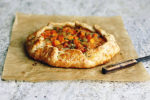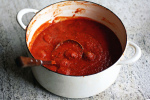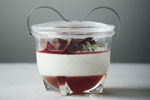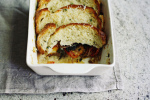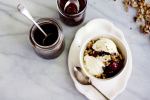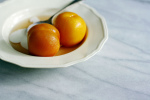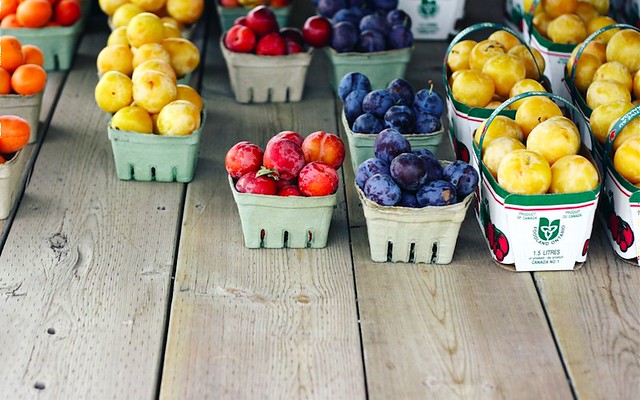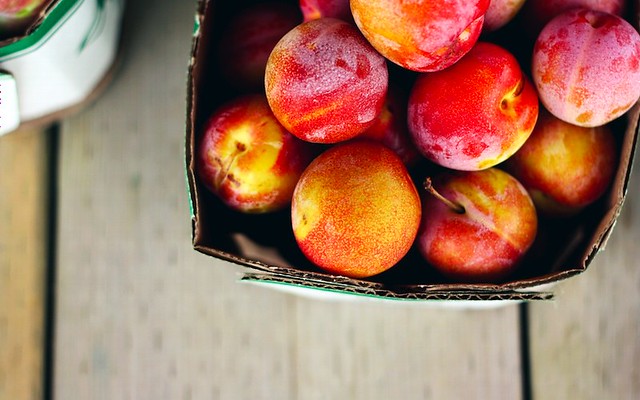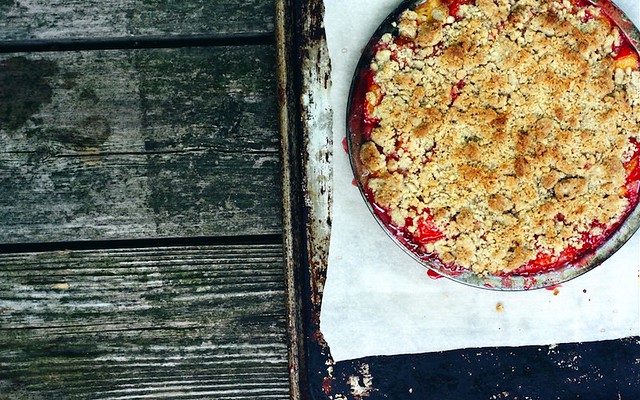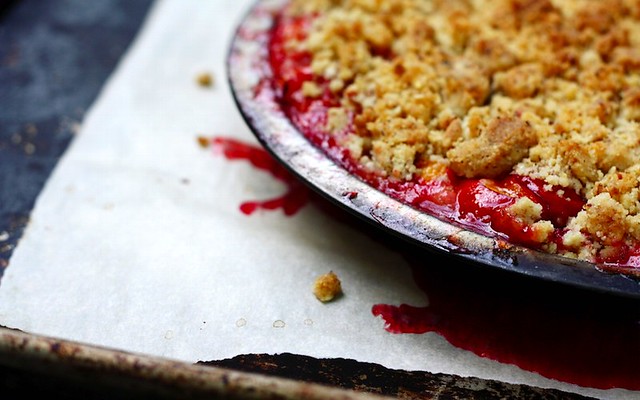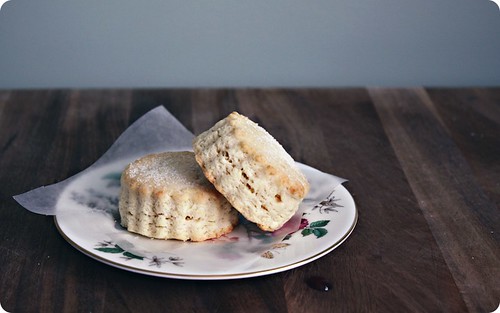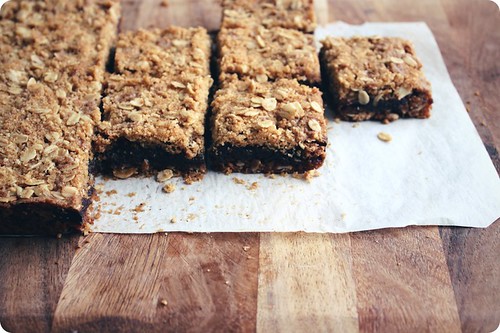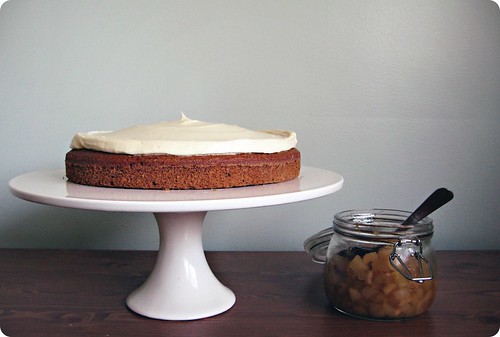The bounty of our greed
 Monday, August 22, 2011 at 8:15AM
Monday, August 22, 2011 at 8:15AM I'm writing at our dining table, having recently moved from one side to the other so as to catch more of the breeze from the open window (now) to my right. I can see across the house from this seat. I can see that out the front window the sun is shining bright like August while, weirdly, over the backyard the sky looks pale grey, dressed in the damp clothes of September.
Autumn's around the bend. That said, we're enjoying these days as we head in its direction.
On Saturday, we set out to snag some peaches; our fourth basket in under three weeks, if my tally is correct. That's the math of late summer. It's the season for a peach feast, and we're enthusiastically obliging. We took along iced tea sweet with lemonade and rugged with ice, because even the shortest of road trips deserve a beverage when the sun's out.
We were aiming for a fruit stand we can get to by taking the long way 'round; twisting through back roads and skirting woods and crossing fields.
We needed the peaches, because there's a drink I've wanted to tell you about, a grown up one. It's a cocktail with peach and lime and mint, spiked with cachaça - the sort of sip that bounces across the tongue like a stone skipping on a lake. Flitting, flirtily, then ending with a splash. I like it a whole lot.
That's not for today, because I got distracted. First, by the couple that owns the stand. They're older, with warm smiles, soft speech and a sharp wit. Their house is beside their stand, with their trees running behind both. She gently pointed out the fruit she thought best, and he talked to my eldest about tractors. We talked about how things are growing, about when the pears might be ready, and about the thermos of coffee stashed behind the baskets of fruit.
Then I was distracted again, this time by plums. They were lookers.
In the case of pretty plums, we did what must be done. We bought a basket, one bigger than sensible. We ate a few in the car on the drive back, along with the blackberries and one of the peaches, because we bought them too. We stained our hands sticky with juice, slurped our tea through straws and then decided what was to be done with the bounty of our greed.
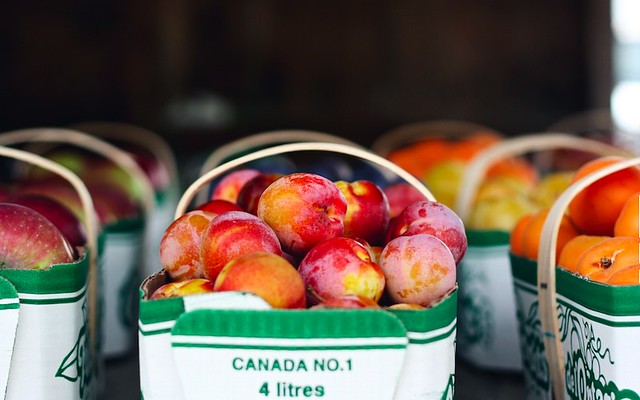
The endpaper to Canal House Cooking Volume No. 4 is a scene of summer's generosity; plums are laid out on a white platter with their emerald, curling leaves still attached; squat looking peaches cozy up to glossy nectarines, apples and pears are in the middle with their yellow-green skin; a punnet of blackberries shine like night from the corner of the frame, beside the matte navy of blueberries. The subtitle for the volume is "Farm Markets and Gardens", and it's a bullseye of an image - summing up everything best of the farm stand we'd visited, and fittingly, it's where I was reminded of the recipe that inspired the dessert we settled upon to celebrate the plums.
In the pages between those endpapers, you'll find a recipe for a Berry Cobbler by Pam Anderson. It's the cobbler that got me started on cobblers, with basically a butter cookie as topper for a layer of vanilla-scented fruit. That's where I began with my thoughts on these plums, as there's a footnote that gives the gentle suggestion of Italian prune plums in place of the berries. I want prune plums for a cake my Mum and I were discussing, so the shockingly-hued reddish golden ones would be my chosen substition for cobbler.
I took some detours along the route to where we ended up, turning down brown butter boulevard for example, but Anderson's cobbler was where we set off from.
Brown butter was beaten with sugar, then an egg and vanilla added to that, along with a mix of flours and some ground almonds. It was basically a rustic shortbread dough - just holding together, gritty with nuts with flecks of brown from the whole wheat and almond skins showing through. It chilled while I set about preparing the plums. They were tossed in brown sugar, cornstarch and a discriminating amount of spices; cinnamon and ginger for a buzz of warmth underneath the plum's sweet acerbity.
The dough was spooned and crumbled over the fruit, and we were ready for the oven. It felt a pie-dish kind of day, so that's what I used, and even though the syrup bubbled over and stuck to the pan, I didn't mind at all.
When baked, the dough crisps on top but soft underneath, with its belly sagging into the fruit. It tastes very much like a biscuit cookie has been crushed on top of a bowl of stewy, supple fruit. In halves and quarters, the pointed edges of the plums droop as they cook, while keeping some shape. There's luxurious weight to them still. The brilliant, fiery orange-pink of the skin seeps into the golden flesh and into the juice, so the colour ends up a mix of peaches and raspberry, though the flavour is plum through and through.
Acting like August or pretending to be September, whatever this day wants to be, wherever it leads, there's cobbler left in the dish and spoons in the drawer, and that's all I need to know.
Brown butter plum cobbler
Inspired by a recipe from Pam Anderson, from her book The Perfect Recipe (Houghton Mifflin Harcourt, 2001) via Canal House Cooking Volume No. 4 - a publication that inspires with every issue. The original recipe calls this a cobbler, with a cookie crust that slightly sinks into bright puddles of fruit. It's a grand dessert, and I urge you to seek it out and try it as written. In fact, try as many recipes as you can from Anderson's book, which is one I consider an essential to have around. Not only is she chatty, witty and totally approachable in her cooking, what's more is that her recipes work. Every. Single. Time. They're tested and then tested again, and she's generous enough to share the results of all that effort.
This recipe is on offshoot of one of her variations for cobbler that best fulfilled our craving yesterday. My changes makes this something different; it has a sandier topping that might tread into the definition of a crisp. But since I'm no expert, and Anderson surely is, I'm leaving her title intact.
I should say that the sugar may be scant for some tastes and is dependant on the fruit; plums are sour and the amount I used kept the twang that hits the point at the back of your jaw right below the ear - it's not so much that the muscle clenches, but there's still a twitch.
For the topping
1 stick unsalted butter
1/2 cup all-purpose flour
1/4 cup whole wheat pastry flour
1/4 teaspoon baking powder
1/8 teaspoon salt
3 tablespoons ground almonds, see note
1/2 cup fine grained raw cane sugar
1 egg yolk
1 teaspoon vanilla extract
For the filling
1 tablespoon cornstarch
1/4 cup light brown sugar packed, or more, depending on your fruit
1/2 teaspoon ground cinnamon
1/4 teaspoon ground ginger
A pinch of salt
1 1/2 pounds plums, pitted, halved if small, quartered if large
In a small bowl, whisk together the flours, baking powder, salt and ground almonds. Set aside.
In a small saucepan over medium-high heat, melt the butter, swirling occasionally. Once the butter has melted, continue to swirl the pot, as the butter begins to darken and brown. When the butter is amber in colour and aromatic, remove it from the heat and pour into a medium heat safe bowl to cool slightly. Pour in the sugar, and beat with a wooden spoon until the mixture lightens in colour. Stir in the egg yolk and vanilla. Add the flours and stir until combined. Refrigerate the dough and preheat an oven to 375°F (190°C).
Combine the cornstarch with the brown sugar, spices and salt in a medium bowl. Add the plums and toss gently to coat.
Tumble the plums into an 8-inch square baking dish. Drop the dough by heaped spoonfuls over the fruit, covering evenly. Bake in the preheated oven until the juices are bubbling and the topping is golden brown, about 40-45 minutes. Let stand to cool slightly before serving.
Serves 4-6.
Notes:
- I think almond is a fine compliment to stone fruit desserts for its subtle, fragrant sweetness and, in this case, its texture as well. I used a handful of natural, skin-on almonds, pulsing them in a food processor to a fairly small, uneven meal. Alternatively, this can be omitted and use a few drops of almond extract instead. On cooler days, hazelnuts or walnuts might be my choice instead.
*******
Something to share:
- My dear friend Tara Austen Weaver wrote a stunner of an ebook about Japan, to benefit Japan and the continued rebuilding efforts after the earthquake and subsequent tsunami last March. The book is now available for purchase, and she's written about her project here.


